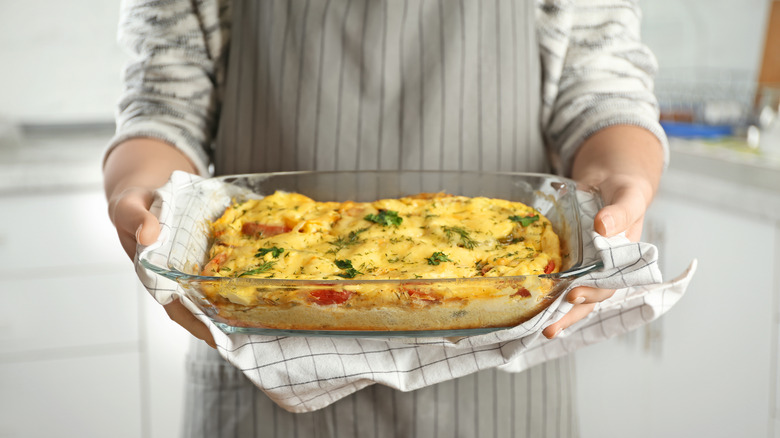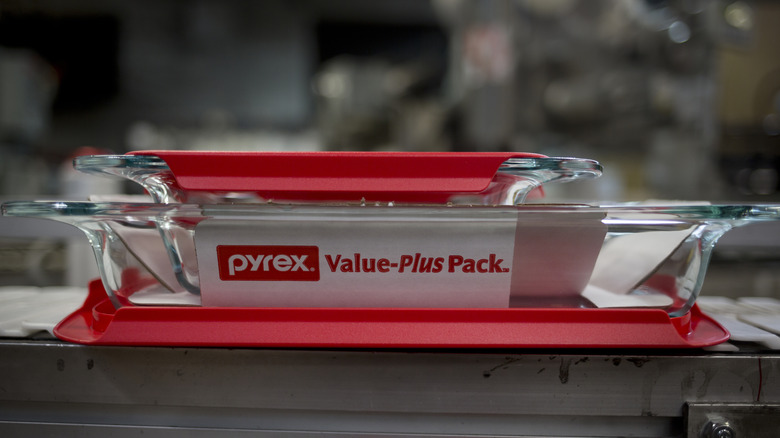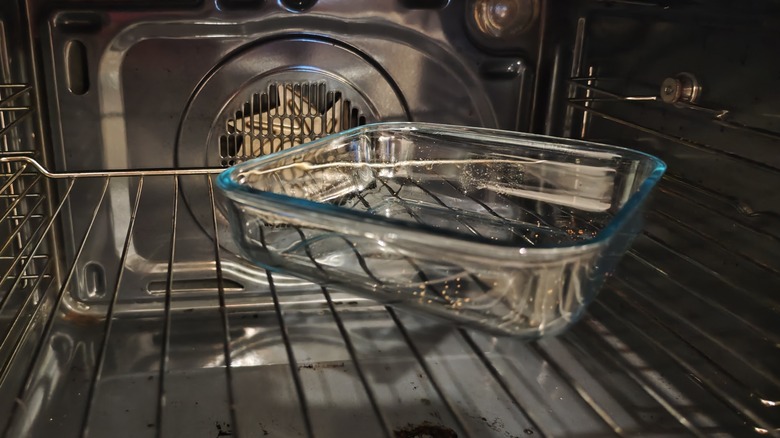Can You Safely Move Pyrex From The Fridge Straight To The Oven?
When Pyrex first came out in the early 1900s, its main selling point was its ability to stand up to very hot and very cold temperatures without shattering, allowing it to be used for a wide range of recipes. To this day, this type of cookware is associated with being durable and versatile. But if you're planning to prepare something in a Pyrex dish, you might be wondering if you can safely move it straight from the fridge to the oven or vice versa.
All Pyrex was originally made with borosilicate, however, in the 1950s the company began manufacturing its cookware with soda-lime, which is a cheaper but weaker glass. After 1998, it became the standard for all Pyrex dishes sold in the U.S. But in Europe, Africa, and the Middle East, it's still made with borosilicate. In these countries, the name is stylized in all caps, as in "PYREX" but in the U.S., the cookware is labeled as lowercase "pyrex."
If this cookware is made with borosilicate it can withstand drastic temperature changes, but Pyrex made with soda-lime cannot.
How to tell if your Pyrex is borosilicate or soda-lime
The capitalization of the logo is usually a good indicator of whether your Pyrex can safely go from one extreme temperature to the other, but it isn't always reliable. This is because in the past, "PYREX" and "pyrex" both were used with borosilicate and soda-lime cookware. If you inherited this type of dish or managed to find a vintage one at Goodwill, there's a chance it was made between the 1950s and 1998, and that would mean it could be either soda-lime or borosilicate, regardless of the capitalization.
If you want to make sure that your Pyrex is borosilicate, you'll have to buy a new, all-caps "PYREX" produced outside the U.S. Otherwise, it's best to play it safe and let your dishes cool to room temperature. The lowercase version made with soda-lime is not recommended for extremely hot or cold temperatures because it will shatter. However, even the kind that contains borosilicate's shatter-resistant properties still has temperature limitations. The hottest it can be is 392 degrees Fahrenheit and the coldest is -40 degrees Fahrenheit.
Why some Pyrex can't handle drastic temperature changes
Pyrex made with soda-lime can't handle drastic temperature changes since it isn't resistant to thermal shock. This phenomenon is the result of a material going from two different temperature extremes so rapidly that it is unable to expand at a steady rate, which in turn causes it to crack. But even though this kitchen tool isn't made of borosilicate, it's still tempered, so it's at least durable and resistant to heat.
However, the soda-lime version of Pyrex has some advantages to the type made with borosilicate because it doesn't break as easily upon impact. So while borosilicate won't shatter because of temperature changes, it won't matter if you accidentally drop it. Chipping due to regular wear and tear also makes it less resistant to thermal shock.
Despite these two types of Pyrex differences, the truth is that both products have advantages. Just make sure you have the appropriate kind if you plan to take it from the fridge to the oven.


